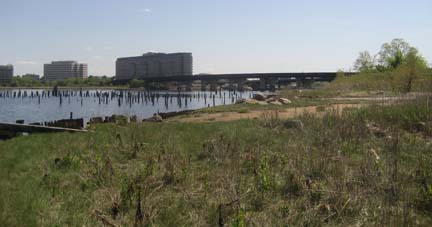December 19, 2013
 Port Norfolk's waterfront: Seized by eminent domain in 1986, this former industrial site will become parkland after a three-year clean-up that begins in 2014. Photo by Bill Forry
Port Norfolk's waterfront: Seized by eminent domain in 1986, this former industrial site will become parkland after a three-year clean-up that begins in 2014. Photo by Bill Forry
State officials and a small gathering of neighbors braved a chilly seaside wind in Port Norfolk last Thursday morning to bring glad tidings that should warm all of us up: The long-delayed clean-up of an old paper factory on the banks of the Neponset River is finally moving ahead. The 14 acre-site — still known to neighbors in the Port as the Shaffer Paper Company — will be transformed into a passive park, connected via the Neponset Greenway trail to the 72-acre Pope John Paul II Park. State leaders say the $4.25 million will be spent over the next three years, with most of the construction work taking place in 2016.
For those many neighbors who live close by in the Port Norfolk neighborhood between Tenean Beach and the Neponset bridge into Quincy, that Thursday was a day some forty years in the making. Many of those who bundled up for the announcement were among those who formed a human blockade to stop dump trucks en route to the Shaffer plant from barreling down their streets in the 1980s.
These same resident-activists helped persuade the Legislature to purchase the land in 1986 and, later, to keep it protected as an “Area of Critical Environmental Concern”— a nod to the fragile ecosystem that populates the salt marsh and wetlands along the coast.
But the fulfillment of the state’s pledge to clean up this site is far more than a parochial triumph for the Port. It is the latest chapter in a half-century long effort to reclaim Dorchester’s waterfront lands, which had largely been fenced and walled off by industry for some hundred years or more. While the factories, junk yards, landfills, and car repair lots that once blocked neighbors from their river and bay are now gone, the remnants of their years of activity remain hazards in places like Port Norfolk. A 2008 survey conducted at the Shaffer plant — which had been used as a lumber yard prior to the paper mill — found “elevated levels of heavy metals including lead and polycyclic aromatic hydrocarbons in the area,” a revelation that has worried nearby residents.
Meanwhile, progress came gradually but dramatically to other important Neponset waterfront areas. In the mid-1990s, an old railway right-of-way was re-purposed as a three-mile multiuse path that we now call the Neponset Greenway. Next, Pope John Paul II Park, the jewel nearby, opened in 2001 after a $7 million project capped, re-graded, and landscaped an old landfill and abandoned drive-in theater near Neponset Circle. In 2006, a new park — Neponset II — was carved out on land near Granite Avenue that once was occupied by a junkyard and tow company. Farther north, smaller piecemeal projects stitched in new elements of the Boston Harborwalk on the Columbia Point peninsula. All the while, the Shaffer Paper site lay dormant and fenced off — a huge missing link in Dorchester’s riverside renaissance.
In 2007, longtime Port Norfolk advocate Maria Lyons spoke to the Reporter at the Shaffer site and noted its significance: “Basically, we feel like it’s the only wild lands left on the Dorchester side of the river. It supports bird nesting and shellfish and all kinds of species. We’d like to protect that for the children,” she said. “Once it’s destroyed, it’s gone. We’d like it to remain, for the most part, wild lands with a small, stone-dust path and benches where people could sit and enjoy the peace of this place.”
The initial DCR plan that has been put forward over the last week seems to capture the vision that Lyons described back then. The Port Norfolk commitment, coupled with the Patrick administration’s promise to fund the extension of the Neponset Greenway into Mattapan and Milton over the next three years, will ensure the preservation of our waterfront for generations to come. All these developments will make our city neighborhoods more attractive and healthier and safer for those who increasingly use the Greenway and its connected parklands to bicycle, walk, or run.


